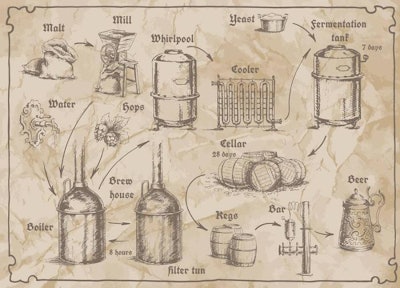
Following one of my recent blogs, Ioannis the nutritionist knows so little about yeast, I received many responses from yeast suppliers trying to explain the differences and unique points of their products. Even more messages were received by nutrition professionals, and this led me to create a list of questions that interested parties would like to ask yeast suppliers, but have not done yet.
I hope that yeast suppliers will decide to address these points of disconcert among nutrition professionals. As the list encompasses questions from an international background, some might be more relevant to certain parts of the world than others. Of course, this is not a poll report, but merely blending my own experiences with those around the world, taking advantage of the great reaction affected by the blog.
1. Why not use brewer’s yeast?
Long before yeast "derivative" products became fashionable, brewer’s yeast was considered a premium ingredient used to increase palatability and digestibility. Why is brewer’s yeast no longer considered a prime ingredient any longer?
2. Why has brewer’s yeast disappeared?
Or, in other words, why is it so expensive any more? Some have suggested it is being repackaged as yeast derivative products, but this is simply an oversimplification. What really happened? Is the dairy industry the culprit here? We all know dairy cows do consume considerable quantities of such yeast worldwide.
3. Dead or alive?
If we have, and research says we do, comparable results with either dead or live yeast, then should we pick the one that is least expensive? Does live yeast offer further benefits down the road? In other words, does live yeast grow and multiply in the gut offering prolonged benefits? Are there any risks associated with that? After all, it is one more alien and alive microorganism in the gut!
4. Does yeast stimulate the immune system?
In most cases it does, but when is this stimulation a risky proposition? Can overstimulation at the wrong time (disease outbreak, stress due to heat, etc.) cause animals to react negatively? As some mention, perhaps yeast is best left for adult animal diets. On the other hand, can we take advantage of this immune system stimulation, and if yes, when and how?
5. Which product is best?
With the plethora of yeast products available, one is at a disadvantage trying to find what works best. What are the criteria in selecting a yeast product? Could protein be such criterion, and if not, what is the next readily recognizable and easy to assess index measurement?
6. Why do inclusion rates differ so much?
If "nutritional" yeast used for protein is used at 5 to 10 percent in the final feed, and "functional" yeast at ten times less this concentration, then do we also get the functional benefits from the oversupply of nutritional yeast? Isn’t yeast just yeast?
If yeast is yeast, then does it matter where it is coming from?
7. Yeast from China, Brazil, or anywhere in the world?
If yeast is yeast, then does it matter where it is coming from? At the moment, users have no real quality control criteria to distinguish one yeast source from the other. Crude protein is simply not enough. Does the process from which yeast is derived play a role? Is yeast produced for animals any different from yeast produced as a by-product from another industry?
Summing up
In brief, yeast production methods, sources, nutrient profiles and quality criteria remain largely a "black box" for nutrition professionals. Such users are called to use a specific product based on its brand name and a number of trials presented to them. This is simply not enough. We need to understand yeast much better before we can place our euros/dollars/yen, etc., on one more expensive ingredient with nutritional and functional properties. Competitors are already ahead!

















